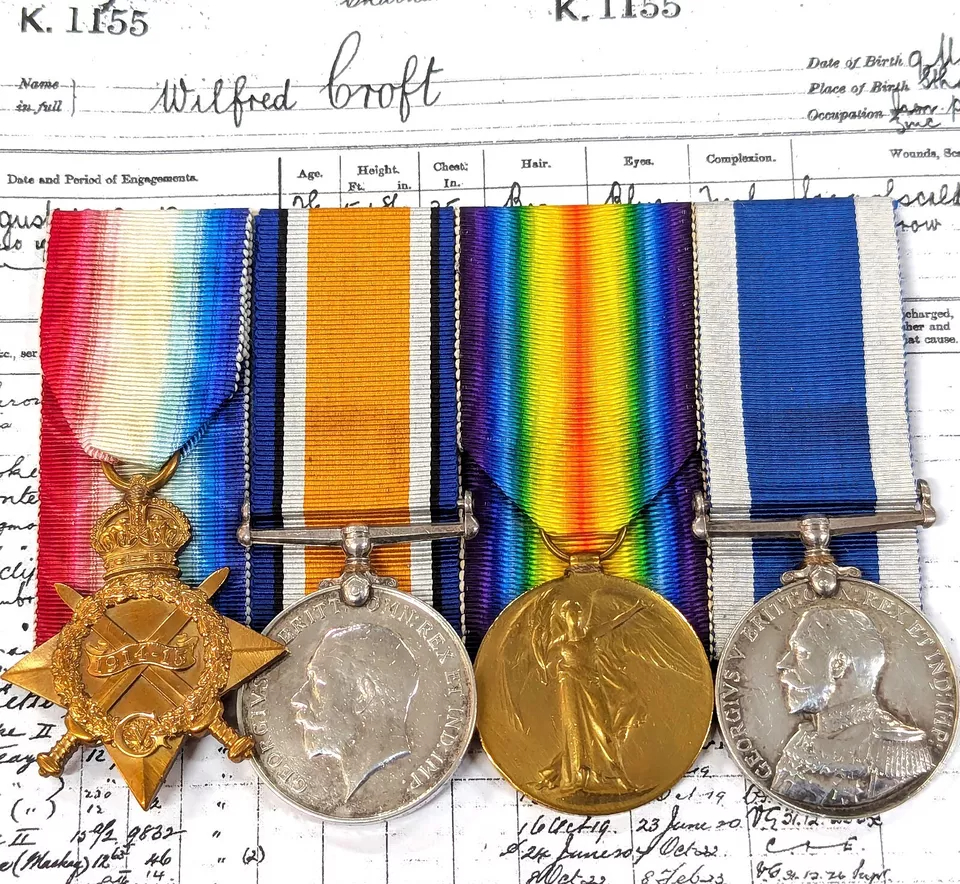For sale is a set of medals comprising the 1914 – 15 Star, British War and Victory Medals (1914 – 18) all impressed named K.1155. W. CROFT. S.P.O. R.N.; Royal navy Long Service and Good conduct Medal (G.V.R.) impressed named K.1155 W. CROFT. S.P.O. H.M.S. VULCAN. Court mounted for display they come with copies of service records.
Chief Petty Officer Wilfred Croft was born on 9/3/1889 in South Hornsey, London. He was working as a zinc plate worker when he enlisted into the Royal Navy as a Stoker 2nd Class on 27/8/1908.
During the Great War he was serving on H.M.S. Landrail (destroyer) the depot ship being H.M.S. Dido, 3rd Destroyer Flotilla Harwich. He served on her from the 24/6/1914 – 11/2/1917 being promoted to Stoker Petty Officer during this time.
On 5/81914, the Third Destroyer Flotilla, led by the light cruiser Amphion carried out a sweep to prevent German minelayers or torpedo craft entering the English Channel. Later that morning, in response to a report from a trawler that a merchant vessel had been acting suspiciously and throwing objects overboard, Landrail and sister ship Lance were ordered to investigate, and came across the German minelayer Königin Luise, laying mines off Southwold on the Sussex coast. The German ship attempted to escape to neutral waters, but was engaged and sunk by Lance, Landrail and Amphion. The flotilla was returning from the sweep on 6 August when it ran into the minefield laid by Königin Luise, with Amphion striking two mines and sinking, with the loss of 151 of Amphion's crew, together with 18 survivors from Königin Luise.
On 28/8/1914, the Harwich Force, supported by light cruisers and battlecruisers of the Grand Fleet, carried out a raid towards Heligoland with the intention of destroying patrolling German torpedo boats. Landrail formed part of the 2nd Division of the Third Flotilla during this operation and took part in torpedo attacks against the German light cruisers Strassburg and Mainz, with Landrail claiming one hit on Mainz.
The Landrail was at the Battle of Jutland but did nothing of interest, however on the 12-13 December 1916, Landrail was on patrol in the Dover Strait when a submerging submarine was spotted. Landrail dropped two depth charges in response, and the attack was credited as a 'Possible', but post war assessment indicated that the German submarine UB-29 was sunk.
He transferred to H.M.S. Setter (destroyer) with the Dido as depot ship from 12/2/1917 – until sunk on 31/5/1917.
Part of the Harwich Force, Tenth Destroyer Flotilla, the ship escorted merchant ships that crossed between the Netherlands and the United Kingdom, termed Dutch traffic, which usually involved a flotilla leader and four destroyers steaming almost every alternate day. It was during one of these operations on 12 March that the flotilla was attacked by German torpedo boats.
On 17 May, while escorting Dutch traffic, Setter was once again part of a flotilla that encountered German torpedo boats. The ships, led by sister ship Sylph and including Minos and Recruit as well as Setter, were covering the rear of the convoy when they saw approaching ships. As the weather was foggy, it was assumed that they were members of the convoy until German voices were heard and a torpedo and three salvoes were fired by the German ships. The torpedo narrowly missed Sylph and the ships lost sight of each other. In the confusion, Setter had to turn sharply to port with engines at full power astern to avoid hitting Recruit. Unfortunately, the manoeuvre put the destroyer straight in front of Sylph, which hit the starboard quarter and caused the engine room to flood. Despite attempts to save the ship, Setter was lost. One merchant ship from the convoy, was sunk by the Germans. There were no casualties aboard Setter.
After survivors leave he was posted to HMS Teazer (destroyer) 18/6/1917 – 15/10/1919.
He discharged to shore pension on 26/8/1930, but was recalled for WW2 on 26/8/1939 serving until 4/6/1945.
Based on his WW2 service records he would be entitled to further medals.




